One of the most commonplace features of Japan that I take for granted is the road gutter. Sure, there are chopsticks, weird square cars, and power lines everywhere, but the ubiquitous gutter is something I've gotten so used to that I sometimes forget that it doesn't exist in America.
Whereas roads in America have grass, dirt, or gravel along the shoulders, Japanese roads tend to have a gutter along one side, if not both sides. I don't know if this difference is due to different road building techniques or simply an adaptation to the monstrous rainy season in Japan, but whatever the case, gutters are everywhere.
There are generally two types of gutters, maybe three. I think of them as the "old type" and the "new type." It's pretty obvious why. The possible third type is really just an old old-type gutter. Here's a typical old-type gutter.
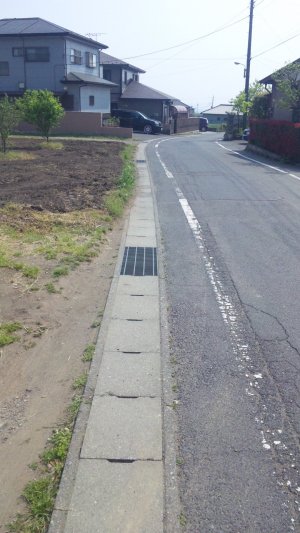
It's pretty plain. Cement blocks with a slight notch in one end to allow maintenance workers to pry them up. There are also regularly-spaced gratings for people to accidentally drop their keys and various other valuables into. I suppose they're also useful for allowing larger rocks and other debris to wash away, or to give people a view of possible obstructions.
The older version is pretty much the same, but with thicker blocks that have rocks mixed in, presumably to make the gutter look more natural or something. They tend to be in terrible disrepair, with cracks and uneven surfaces that make biking a major pain in the ass. I once punctured a tire going over old old-type gutters -- no joke.
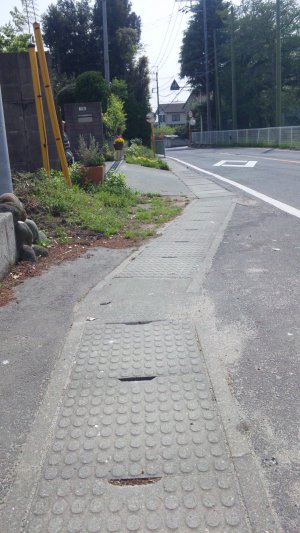
The newer version is slightly different. It tends to be textured somehow -- repeated patterns, circles, squares, diagonal lines -- anything is okay, apparently. Like the older gutters, they have notches in the top for ease of removal. One major difference is that the new ones tend to be much wider, as they were put in with street renovations that included enlarging gutters. I guess it helps get water through faster and also helps prevent clogs from leaves and other crap.
I kind of prefer the old ones just because they're smoother riding without the texture, but there really isn't all that much of a difference. You can find either type all over and both types are actually intermixed in a lot of places. If you look closely, you'll see that the new-type gutter gives way to an old-type gutter halfway up the picture.
Gutters are often used as sidewalks, since there's no real shoulder or sidewalk to speak of most of the time. Fences such as the one above give pedestrians a bit of added safety, though they're not all that common. A lot of times, Japanese roads are about a car-and-a-half wide, so a car will have to pull over to the shoulder, on top of the gutter, in order to let another car pass by.
One notable feature of the new-type gutters that isn't shown here is that some of them are actually slightly slanted inward toward the middle, which directs water a bit more. It's annoying to bike on, though.
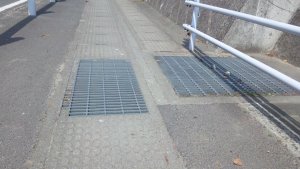
Grates like the one on the left are placed in the gutter every 15-20 tiles or so, usually. They really are great for losing small valuables; sometimes elementary school kids drop crap in a gutter through a grate and someone has to come out with a crowbar to pick it up and get whatever fell down.
Larger grates like the one on the right are less common, but aren't all that rare, either. This is actually on a mountain road, so I guess there's a lot of run-off from rains up the mountain as well as melting snow in the spring, hence the double gutter on this particular stretch of road.
One notable thing about these grates is that they can get very, very slipper when wet; if I have to slow down or turn, I make sure I'm not anywhere near a grate, since I've had some sprawls caused by them in the past. Nothing painful or serious, just embarrassing.
Another notable thing is that a lot of the larger ones tend to have rocks on/wedged into them thanks to playful kids. Just one more biking hazard to watch out for.
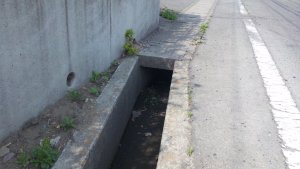
Sometimes, gutters give way to uncovered sections -- traps for the unwary cyclist in either daylight or dark. I've fallen into them once or twice... it wasn't fun and it certainly was wet. You can see that the shoulder thins to almost nothing, so if it's raining and/or dark, there's a pretty large chance that you'll accidentally slip or veer into an uncovered gutter if you're not careful.
This one is actually atypical, since it was made this way -- the uncovered gutters usually have tracks along the upper edges where tiles were or could be laid down.
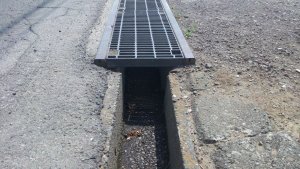
Here's another uncovered gutter, but a different variation. When this road was renovated in the past, the old old-type gutters were never really replaced except at the point where cars had to drive over the gutter to get to a parking lot. Those were replaced entirely by metal grates instead of the standard cement tiles.
You can actually see the type of cement I was talking about in the gutter itself here. It's mixed with rocks to create a more natural, pebbly finish.
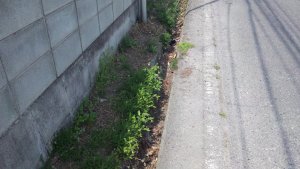
Sometimes old gutters are never covered and just fall into disrepair. This makes it a bit dangerous for cyclists and pedestrians alike, as the unwary ones could simply slip and fall into a hard-to-see gutter. Rains don't do much to clear them out either; the dead leaves and weeds just turn into muck that clogs up the gutter even more. Old gutters never die, they just fill up.
One of the nice things about gutters that I always mention is that they're loose enough in their mountings to make a nice, solid, somewhat musical clunking noise when I ride over them. Over the last three years, I've come to associate that noise with biking in general, so I can't imagine biking around without hearing it.
There are a few more pictures I want to take, but I have to find the right gutters to take them at... so expect another gutter post in the future sometime.
0 comments:
Post a Comment